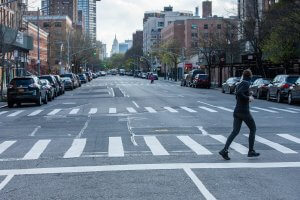
COVID-19 has dramatically altered how people live their daily lives and engage with transportation. Photo @Wikimedia Commons.
The infrastructure bill recently passed by the United States Senate could foster economic growth in the region as has been the case historically with infrastructure investment in New Jersey. CAIT-affiliated researcher, Dr. James W. Hughes, discusses this opportunity and potential roadblocks to economic recovery such as the ongoing COVID-19 Pandemic and rising inflation rates.
Dating back to the start of the twentieth century, periods of economic growth in New Jersey have largely followed new and innovative investments in transportation infrastructure.
In 1917 New Jersey established the first highway department in the nation. That led to building nation-leading innovations throughout the 20s, 30s and 40s such as the first divided freeway linking two cities (Pulaski Skyway) and the first cloverleaf interchange, said Dr. James W. Hughes, dean emeritus of the Edward J. Bloustein School of Planning and Public Policy at Rutgers and a researcher at the Center for Advanced Infrastructure and Transportation (CAIT).
That investment positioned the state for economic growth after World War 2, he said. Then, in the 1960s the state’s first two toll roads — the New Jersey Turnpike and the Garden State Parkway — that were built a decade earlier provided the foundation for a new wave of sustained economic growth. The completion of the Interstate Highway System in the 1980s and 1990s again provided a new wave of economic advances.
“Today, the state confronts a new era of transportation challenges as well as limited resources,” Dr. Hughes said. “The proposed infrastructure bill represents a substantial investment in roadways, bridges, and transportation infrastructure that the region hasn’t seen on such a large scale in decades. This type of investment is what could help spur growth again in the 2020s and 2030s.”
However, in the short-term, Dr. Hughes said that as the economy continues to recover from COVID-19 some obstacles to recovery still remain, and some emerging trends may shape how economic growth develops in the region.
Delta Variant and COVID-19
Recent reports from the National Bureau of Economic Research show that by the numbers the COVID-19 recession technically started in February 2020 and ended in April 2020 — making it the shortest but also one of the worst recessions ever recorded, he said.
“Recessions are measured from their peak to the low point,” Dr. Hughes explained. “People might not realize that even though the recession is technically over, that does not mean that we have recovered all of its employment losses. In fact, because the low point was so bad we are still recovering now even after having already made significant gains.”
Over the approximately 16-month recovery NJ and the nation have made real progress, he said. For example, at the end of the second quarter of 2021, all of the nation’s economic output as measure by Gross Domestic Product (GDP) was fully recovered, however nationally only about 70% of jobs had been recovered and 60% in New Jersey.
Dr. Hughes also said that the rise in COVID-19 cases due to the Delta variant will likely put a dent in growth — between slowing up international supply chains and people potentially being more hesitant to take public transit or go out to eat again — but will not derail current positive trends as people and businesses have somewhat adapted to pandemic.
“This will cause more of a pause rather than a stoppage,” he said. “Recoveries are never smooth or even, and there are always speed bumps along the way.”
Rising Inflation Rates

Dr. James W. Hughes. Photo ©Rutgers University.
Another economic concern is the inflation rate which is around 5%. Dr. Hughes said that there is a lot of uncertainty still surrounding this, but that some short-term factors might be at play such as people jumping into the housing market, supply chain disruptions, and companies adapting to labor shortages and increasing starting salaries.
He added that there is a possibility inflation is longer-term, and that returning to the “Goldilocks economy” of 2018/2019 with full employment and inflation below 2% might not be realistic in the short term.
“This is a new worry that we didn’t have two or three years ago, and there is still a lot of uncertainty,” Dr. Hughes said. “Especially as that previous economic cycle was interrupted by a global pandemic, which we are still recovering from to this day.”
Impacts of rising inflation and labor shortages could also affect the implementation of the infrastructure bill, Dr. Hughes said.
For example, he said that a scenario could emerge where current labor shortages impact the ability to fill new jobs created by the bill. Additionally, the rise in inflation as well as supply chain disruptions still being caused by COVID-19 could potentially cause the price of concrete, steel, and other building materials to increase as new infrastructure projects move to the construction phase.
2020 Census Results
New insights from the 2020 Census provide a look into how the economy, transportation patterns, and population growth in New Jersey might change looking forward.
Dr. Hughes said that based on all estimates, the state’s population came in 398,000 people higher than it did in 2010 — a result of some population growth but also more accurate surveying this time around compared to 2010, and more resources being allocated to the process.
Fast growth was registered in urban areas such as Hudson and Essex Counties, but also in suburban counties such as Ocean and Somerset, he said.
“We have been seeing trends of young families moving away from the city and into the suburbs and areas with more space to begin raising families,” Dr. Hughes said. “COVID-19 really pushed a lot of people who were still sitting on the fence to make this decision as well. Post-census population estimates will fully document this trend.”
He added that as the suburbs grow and people continue working from home, it might impact how companies look to build and set up offices, regional travel patterns, and could reshape economic growth in the state moving forward.

